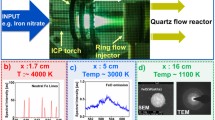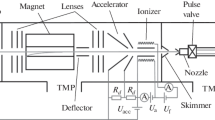Abstract:
Smaller gold-cluster anions, typified by Au 7 -, adsorb multiple CO molecules in a high-pressure, room-temperature flow-reactor, tending toward previously unknown saturation compositions, Au7(CO) 4 -. The weakness of the gold-carbonyl adsorption bond is evidenced indirectly by the high CO partial pressure required and more directly by the high probability of fragmentation in the field-free flight region of the reflectron-type time-of-flight mass spectrometer. The analysis of this metastability reveals that the actual distribution fN,M of products Au7(CO) M - in the reactor may be highly non-statistical, e.g. with only even-M species present.
Similar content being viewed by others
Author information
Authors and Affiliations
Additional information
Received 17 April 2001
Rights and permissions
About this article
Cite this article
Wallace, W., Whetten, R. Metastability of gold-carbonyl cluster complexes, Au N(CO) M - . Eur. Phys. J. D 16, 123–126 (2001). https://doi.org/10.1007/s100530170075
Issue Date:
DOI: https://doi.org/10.1007/s100530170075




